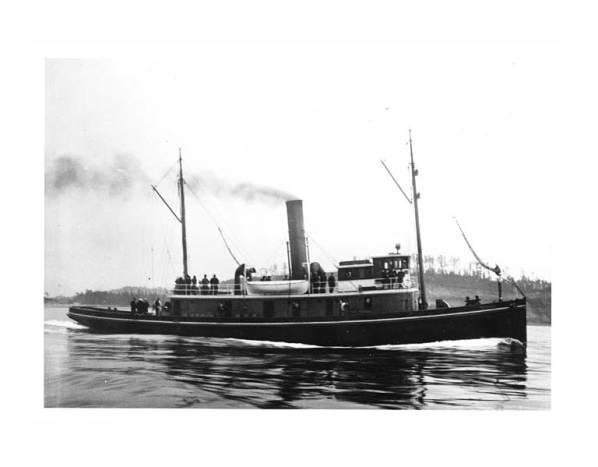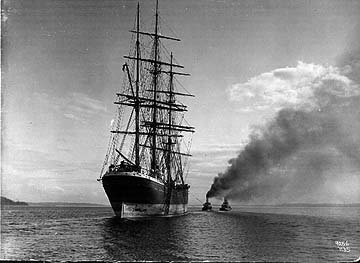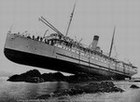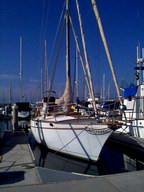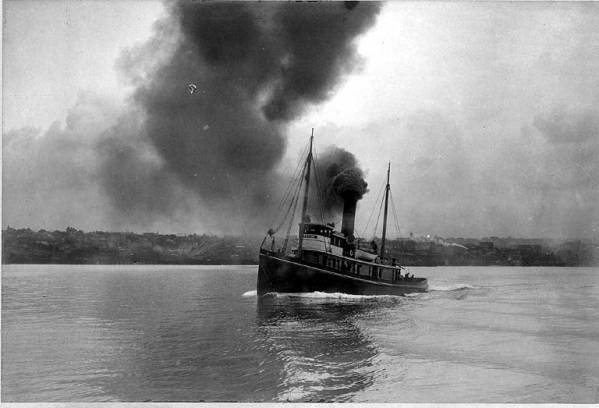
TATOOSH - An exceptionally fine steel tug was produced at Moran Bros. Co. in Seattle, setting a new standard for the towing fleets of the Pacific Northwest. Built to the specifications of Capt. Libby for the Puget Sound Tug Boat Co., the Tatoosh was a 277-ton vessel with dimensions of 119.2 x 25.2 x 15.5. Her triple-expansion engine with cylinders 16, 24, 40 developed 1,000 horsepower and was furnished steam by two Scotch marine boilers. Capt. Buck Bailey, Engineer Primrose and Mate Williams rode the new tug down the ways at her launching and then embarked with her on a distinguished career on North Pacific waters which was to include the saving of dozens of lives from the violence of the sea.
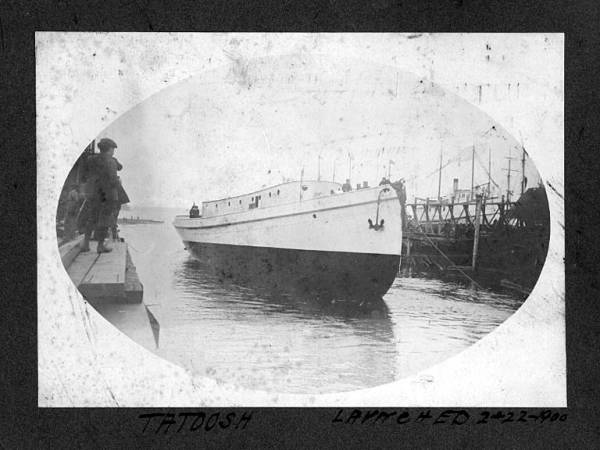
Here are some of TATOOSH's exploits:
ALOHA - Four masted schooner of 814 tons carrying a million feet of lumber was built in 1891 by Hall Brothers at Port Blakely. Owned first by A.H. Paul, San Francisco, she was later taken over by a single-ship company managed by Hind, Rolph and Co. Arriving off Tatoosh waterlogged in December, 1913, from the Fiji Islands to Grays Harbor, she was taken in tow by the tug Tatoosh. The weather rising, she was abandoned by the crew, broke loose from the tow, and foundered. John Lyman.Pacific Coast Built Sailers, 1850-1905,"
 CHARLES E. MOODY - The full-rigged ship Charles E. Moody, a Bath-built Downeaster of 1882 belonging to the Northwestern Fisheries Co., made the passage of 1,350 miles from Puget Sound to Orca, Alaska in 10 days, in 1911. having been taken as far as the ape by the tug Tatoosh. Capt. Peter Bergman commanded the ship on the voyage north, the average time for which, by sailing vessels of he fisheries fleet, was in excess of 15 days. Gordon Newell, "Maritime events of 1911," H.W. McCurdy Marine History of the Pacific Morthwest., p. 186.
CHARLES E. MOODY - The full-rigged ship Charles E. Moody, a Bath-built Downeaster of 1882 belonging to the Northwestern Fisheries Co., made the passage of 1,350 miles from Puget Sound to Orca, Alaska in 10 days, in 1911. having been taken as far as the ape by the tug Tatoosh. Capt. Peter Bergman commanded the ship on the voyage north, the average time for which, by sailing vessels of he fisheries fleet, was in excess of 15 days. Gordon Newell, "Maritime events of 1911," H.W. McCurdy Marine History of the Pacific Morthwest., p. 186.JAMES DRUMMOND - The barge James Drummond, the 1,556-ton former Downeast sailing vessel of 1880, southbound from Gypsum, Alaska with a full cargo of gypsum rock for Tacoma, went ashore on Dall Patch Shoal, Milbanke Sound on October 22. In addition to 2,000 tons of gypsum, the Drummond was carrying a locomotive. She was in tow of the tug Tatoosh, which made an unsuccessful effort to refloat her, afterward removing the crew, except Capt. H. A. Frieze, and proceeding with them to Puget Sound. For some time it was hoped that the Drummond could be refloated, but Canadian authorities refused to permit American salvage vessels tooperate at the scene of her stranding, and during the ensuing delays she broke up and became a total loss. Gordon Newell, "Maritime Events of 1914," H. W. McCurdy Marine History of the Pacific Northwest., p.246.
CAVOUR - The Italian bark Cavour (ex-Auonmore) received the doubtful honor of becoming the first vessel of her nationality to be lost on the Columbia River bar. She had been at anchor awaiting a favorable wind on the bar when a strong easterly came up on December 8, combining with a strong ebb tide, with the result that she dragged anchor and stranded on the sands two miles south of Cape Disappointment. The bar tugs Wallula and Tatoosh attempted to free the square rigger but to no avail. The Point Adams lifesaving crew was successful, however, in removing Capt. Telemore Sofianos, the crew of 16 men, and the ship's dog. The vessel, owned in Genoa and built in Nova Scotia in 1881, became a total loss. She had been outward bound with 1,038,000 feet of lumber for East London, South Africa. Gordon Newell, "Maritime Events of 1903," H.W. McCurdy Marine History of the Pacific Northwest., p. 95.
ROSECRANS - On January 7 the Associated Oil Co. tank steamer Rosecrans, deeply laden with 20,000 barrels of crude oil and in charge of Capt. L. F. Johnson, was laboring through heavy seas and 55-mile-an-hour winds, inbound for the Columbia River from San Francisco. The tanker overran the channel and grounded bow-on in the surf of Peacock Spit at the north entrance of the river, near where the steam schooner Washington was snatched from almost certain destruction by the tug Tatoosh two years earlier. The Rosecrans broke in two at about eight a.m., most of the crew taking to the rigging, from which all but four were swept by the breakers before the arrival of the Point Adams lifeboat. One of these, an oiler, was taken aboard the lifeboat dead, only three being saved from the crew of 35. Both vessel and cargo were a total loss. The officers of the Rosecrans, all of whom perished were as follows: Capt. Lucien F. Johnson, who was only 29 years of age, had been employed by the Associated Oil Co. for more than seven years, and had lived with his widowed mother at San Francisco; Chief Engineer Richard Grundell, who was survived by a wife and three children in San Francisco; First Officer Thomas Mullins, Second Assistant J. L. Adams; Third Assistant Norman Fife (the son of the late Col. W. J. Fife of Tacoma, for whom the town of Fife, Washington was named); Chief Steward Fred Wilson; Wireless Officer L. A. Prudhont; Boatswain Peter Uren; Electrician Milton Enetson and Carpenter Eric Linkmark. * *It was said that misfortune had perched on the forefoot of the Rosecrans when she was launched at Glasgow as the Methuen Castle 29 years before, and had never left her, her fatal stranding having been her third wreck within a year. She had gained early notoriety in Castle Mail service when Carey, one of the notorious nineteenth century Phoenix Park murderers, who turned state's evidence against his confederates in the assassination in Dublin of Lord Charles Cavendish, was said to have escaped to South Africa aboard her, but was tracked half way around the world and shot down on the Castle Line coastal steamer Melrose at Cape Town by avengers who had taken the Irish Republican oath of "death to informers". Coming under American registry as a government transport, she was found unsatisfactory and sold out of service, becoming more actively unfortunate following her conversion to a tanker. On March 12, 1912 she became unmanageable in a gale and was tossed broadside onto the rocks at Gaviota (Alcatraz Landing) 20 miles north of Santa Barbara. The carpenter and quartermaster were washed overboard and drowned during efforts to launch the boats. The vessel was listed as a total loss, having a 25-foot hole in her hull and being firmly impaled on the rocks, but she was refloated and repaired at heavy cost, only to catch fire five months later while loading at Gaviota (Alcatraz Landing). She had only recently returned to service following a complete rebuilding. Gordon Newell, "Maritime Events of 1913," H.W. McCurdy Marine History of the Pacific Northwest., p.228
 WASHINGTON - November 13, 1911 Steam schooner, 539 tons, built at Seattle in 1906. When she ran aground, the newspapers felt so sure that the Columbia River bar sands would swallow the stricken vessel, they ran headlines "Forty Eight Doomed" and "Schooner Washington Driven Ashore," but much to everyone's surprise and relief, Captain Buck Bailey came along in his big tug Tatoosh and effected a dramatically successful rescue. Don Marshall, "Ship Disasters, Cape Falcon to Cape Disappointment. Portland: Binfords, 1984, p. 133-134
WASHINGTON - November 13, 1911 Steam schooner, 539 tons, built at Seattle in 1906. When she ran aground, the newspapers felt so sure that the Columbia River bar sands would swallow the stricken vessel, they ran headlines "Forty Eight Doomed" and "Schooner Washington Driven Ashore," but much to everyone's surprise and relief, Captain Buck Bailey came along in his big tug Tatoosh and effected a dramatically successful rescue. Don Marshall, "Ship Disasters, Cape Falcon to Cape Disappointment. Portland: Binfords, 1984, p. 133-134
